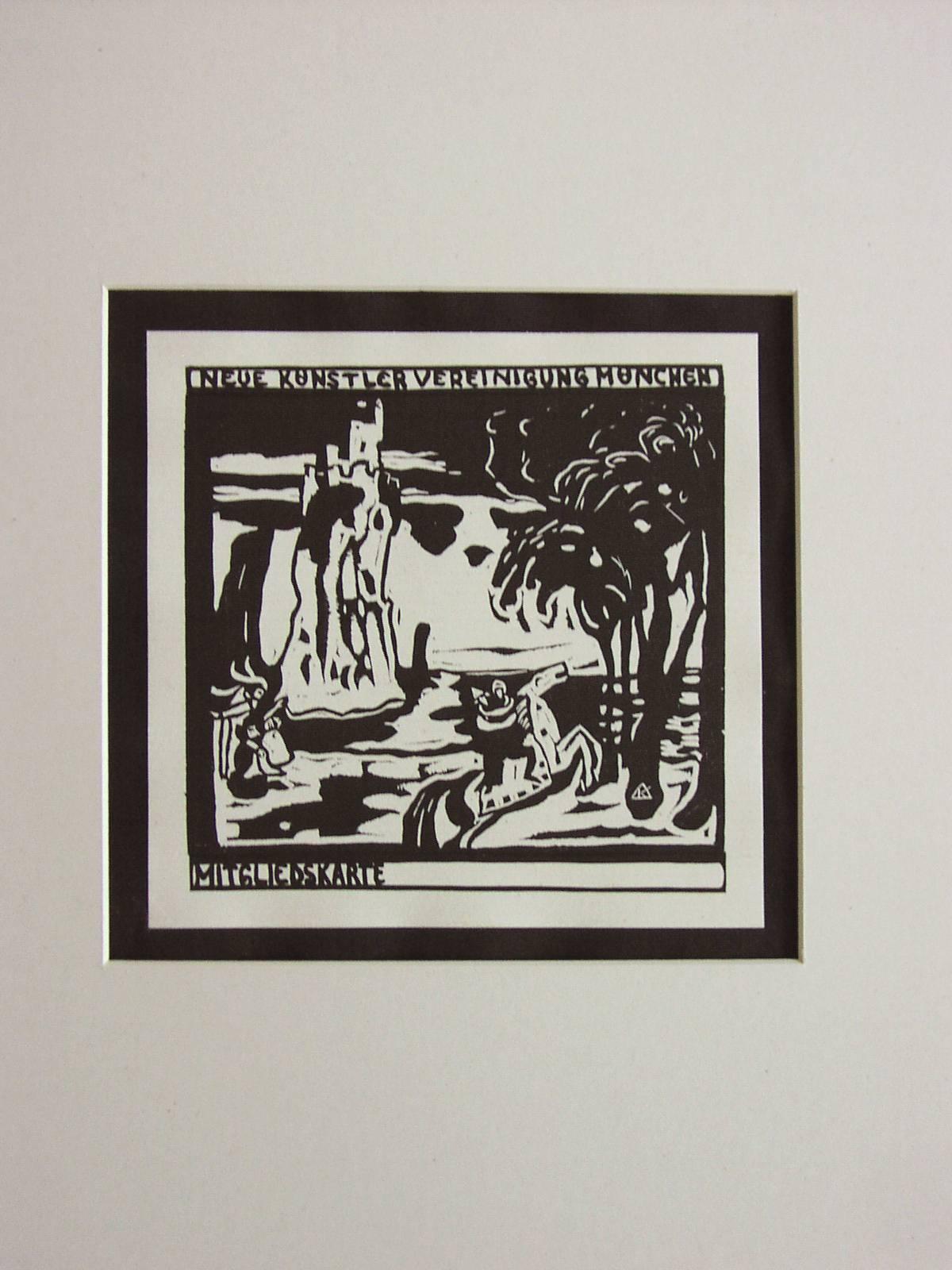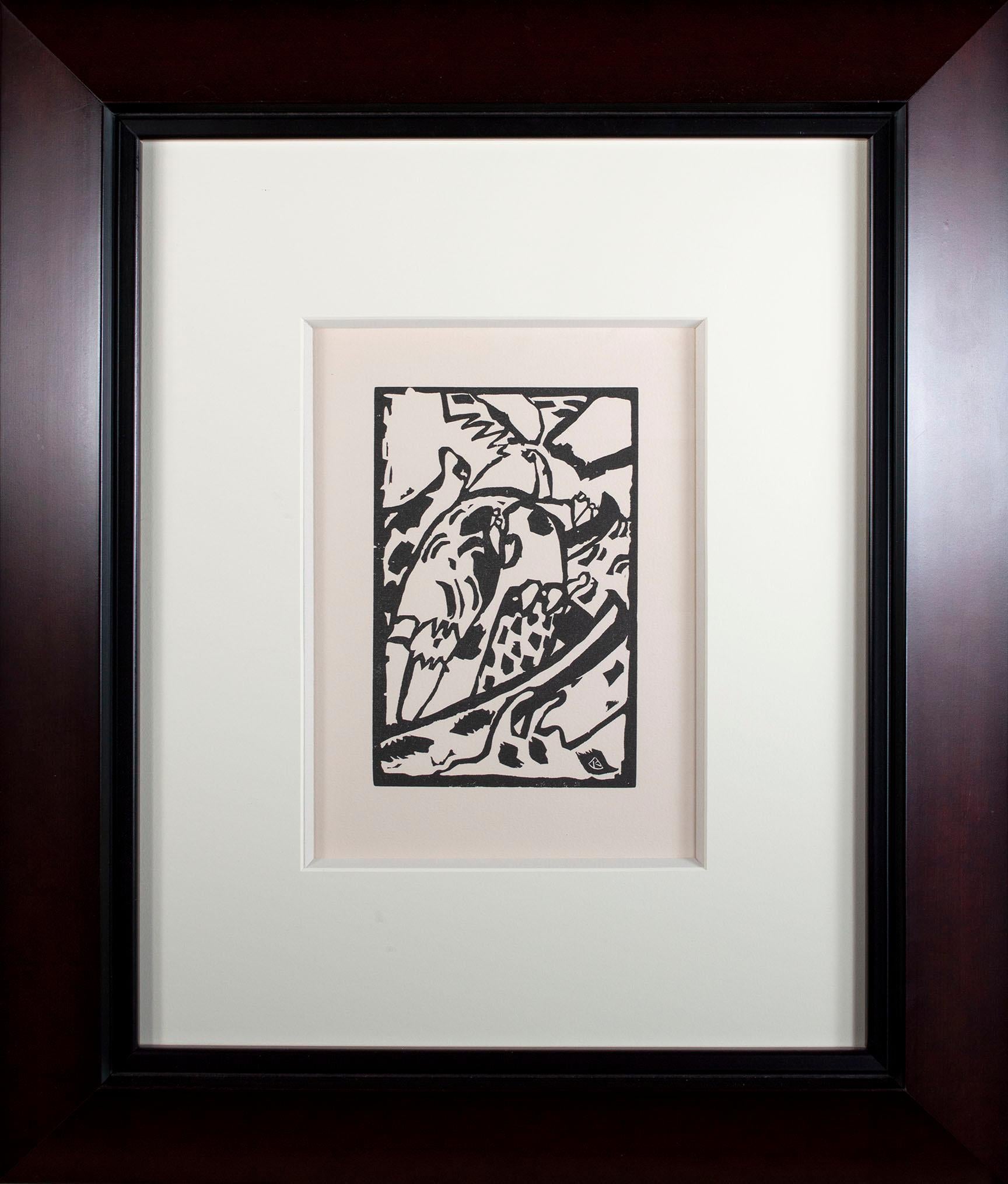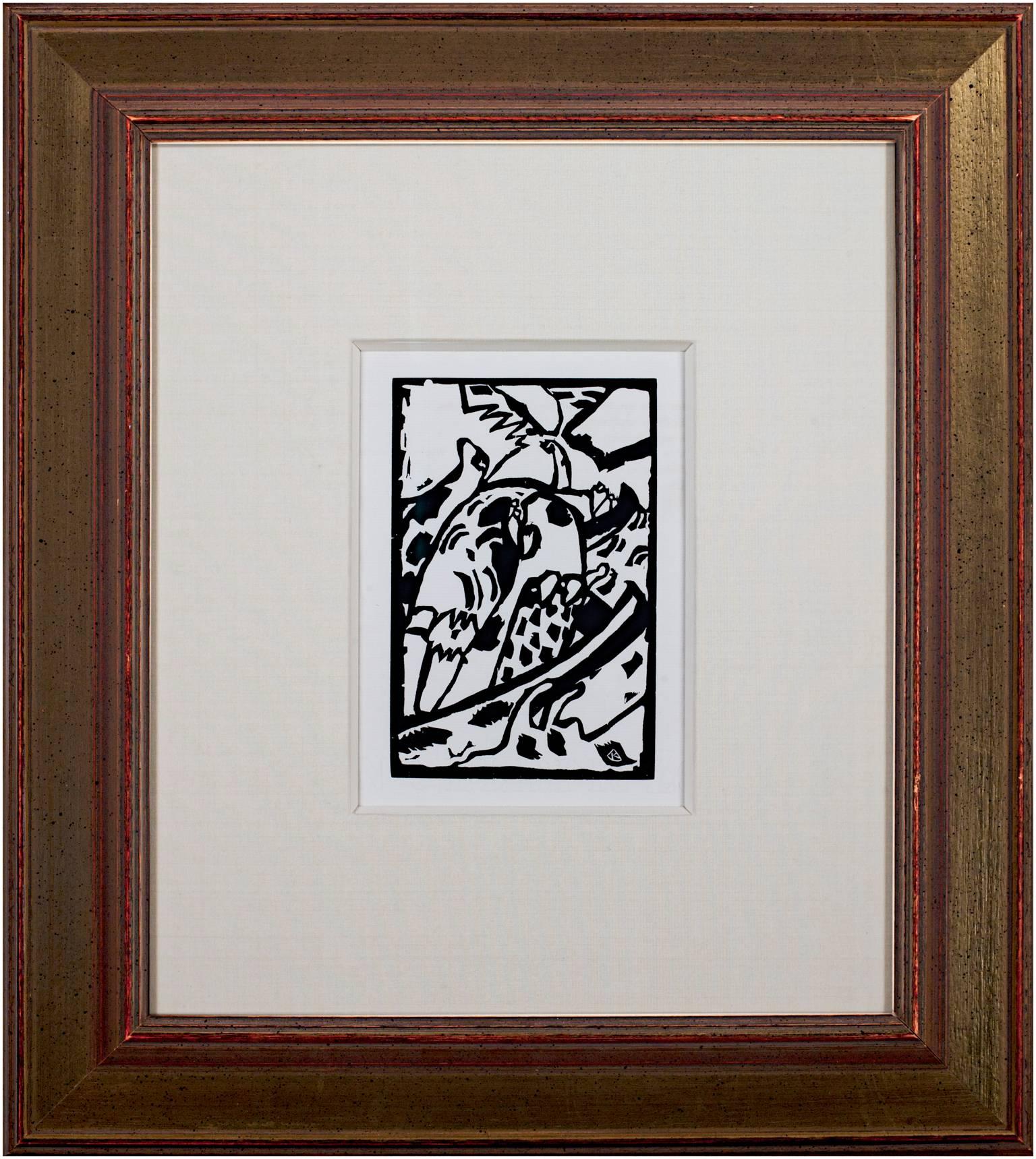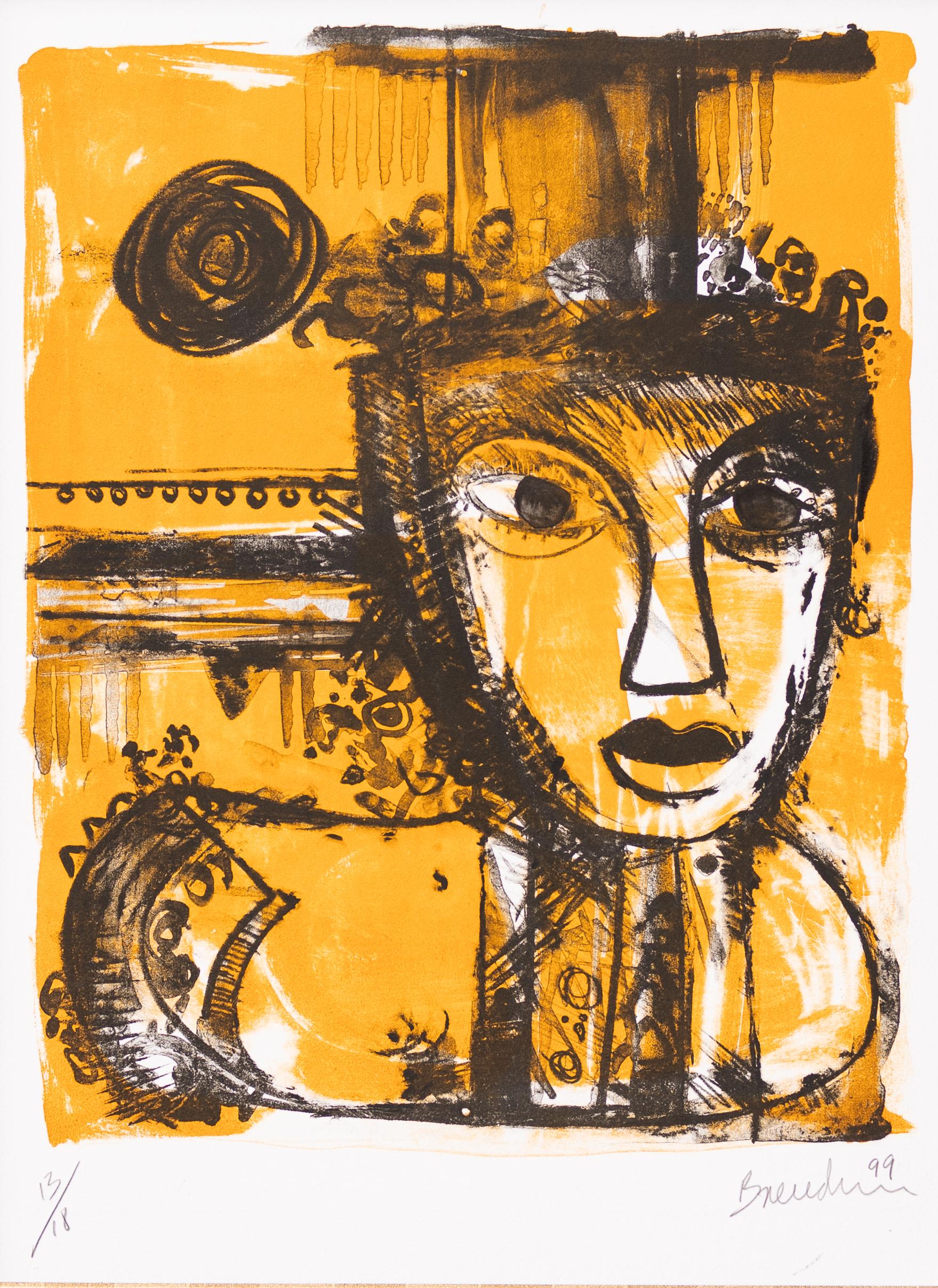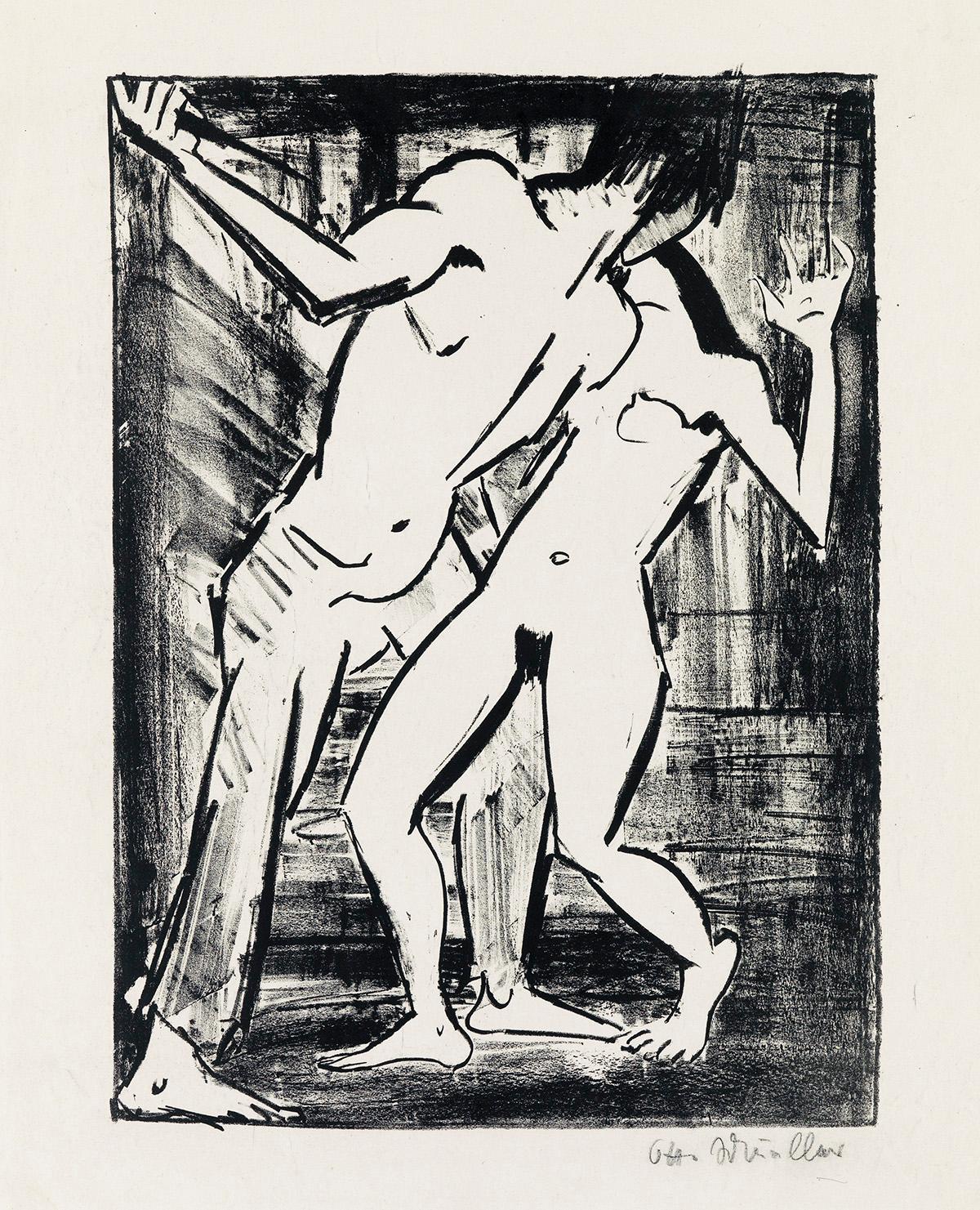Items Similar to 'Nuits de la Fondation Maeght' original lithograph event poster
Want more images or videos?
Request additional images or videos from the seller
1 of 8
(after) Wassily Kandinsky'Nuits de la Fondation Maeght' original lithograph event poster1971
1971
About the Item
This poster, published in 1971 for the Fondation Maeght, proudly boasts a lithographic rendering of Wassily Kandinsky's 1922 mural plans for the Juryfreie exhibition in Germany. It was in 1922 that Kandinsky was invited to teach at the Bauhaus in Weimar, Germany. There, he threw himself into an intensive period of artistic and theoretical production. With his students, the painter worked on monumental decors, including this mural cycle. The Bauhaus was closed in 1933 under the risign threat of Nazism, and Kandinsky ended this creative period and left for France. The composition places bursting forms of color against a dark black background, emblematic of the modern master's expressionist style.
This poster has been cut down from its original size. The text originally at the bottom is included on the back of the frame.
21 x 22.13 inches, artwork
29.5 x 30.88 inches, frame
Published by Imprimerie Arte Paris
Framed to conservation standards using archival materials including 100 percent rag mounting, UF5 Plexiglas to inhibit fading, and housed in a silver finish wood moulding.
Wassily Wassilyevich Kandinsky (16 December 1866 – 13 December 1944) was an influential Russian painter and art theorist. He is credited with painting the first purely abstract works. Born in Moscow, Kandinsky spent his childhood in Odessa. He enrolled at the University of Moscow, studying law and economics. Successful in his profession—he was offered a professorship (chair of Roman Law) at the University of Dorpat—he began painting studies (life-drawing, sketching and anatomy) at the age of 30.
In 1896 Kandinsky settled in Munich, studying first at Anton Ažbe's private school and then at the Academy of Fine Arts. He returned to Moscow in 1914, after the outbreak of World War I. Kandinsky was unsympathetic to the official theories on art in Communist Moscow, and returned to Germany in 1921. There, he taught at the Bauhaus school of art and architecture from 1922 until the Nazis closed it in 1933. He then moved to France where he lived for the rest of his life, becoming a French citizen in 1939 and producing some of his most prominent art. He died at Neuilly-sur-Seine in 1944.
- Creator:(after) Wassily Kandinsky (1866 - 1944, Russian)
- Creation Year:1971
- Dimensions:Height: 29.5 in (74.93 cm)Width: 30.88 in (78.44 cm)
- Medium:
- Movement & Style:
- Period:
- Condition:
- Gallery Location:Milwaukee, WI
- Reference Number:
About the Seller
4.9
Platinum Seller
These expertly vetted sellers are 1stDibs' most experienced sellers and are rated highest by our customers.
Established in 1966
1stDibs seller since 2017
391 sales on 1stDibs
Typical response time: 1 hour
- ShippingRetrieving quote...Ships From: Milwaukee, WI
- Return PolicyA return for this item may be initiated within 14 days of delivery.
More From This SellerView All
- 'Improvisation 7' second ed. woodcut from 'Klänge' by Wassily KandinskyBy Wassily KandinskyLocated in Milwaukee, WI'Improvisation 7' second ed. woodcut from 'Klänge' is a woodcut print created by Wassily Kandinsky. The present woodcut print comes from the second edition of 'Klänge (Sounds),' a book of original graphics and poetry by Wassily Kandinsky. The title of the album and of this print, 'Improvisation,' demonstrated Kandinsky's interest in music and how abstract musical forms could be translated into images on a two-dimensional surface. This particular composition is difficult to read, but through the abstraction, one can make out various figures and a landscape beyond. Originally carved and printed in 1911, this second edition print was done ca. 1938. It is a woodcut in black ink on woven paper. Signed with encircled 'K' in the block, lower right (from the book, signed in ink, ed. 117/300) Image Size: 7 1/2" x 5 inches Frame Size: 22 1/4" x 18 3/4" Ref. Roethel 124 Artist Bio: The Museum of Modern Art described 'Klänge (Sounds)' as follows: Vasily Kandinsky's self-described "musical album," Klänge (Sounds), consists of thirty-eight prose-poems he wrote between 1909 and 1911 and fifty-six woodcuts he began in 1907. In the woodcuts Kandinsky veiled his subject matter, creating increasingly indecipherable images (though the horse and rider, his symbol for overcoming objective representation, runs through as a leitmotif). This process proved crucial for the development of abstraction in his art. Kandinsky said his choice of media sprang from an "inner necessity" for expression: the woodcuts were not merely illustrative, nor were the poems purely verbal descriptions. Kandinsky sought a synthesis of the arts, in which meaning was created through the interaction of, and space between, text and image, sound and meaning, mark and blank space. The experimental typography shows his interest in the physical aspects of the book. Klänge is one of three major publications by Kandinsky that appeared shortly before World War I, alongside Über die Geistige in der Kunst (Concerning the Spiritual in Art) and the Blaue Reiter almanac...Category
1910s Blue Rider Abstract Prints
MaterialsWoodcut, Laid Paper
- 'Improvisation 7' original first ed. woodcut from 'Klänge' by Wassily KandinskyBy Wassily KandinskyLocated in Milwaukee, WIThe present woodcut print comes from 'Klänge (Sounds),' a book of original graphics and poetry by Wassily Kandinsky. This first edition was released in an edition of 300, each book signed and numbered by the artist. The title of the album and this particular print, 'Improvisation,' demonstrated Kandinsky's interest in music and how abstract musical forms could be translated into images on a two-dimensional surface. This particular composition is difficult to read, but through the abstraction, one can make out various figures and a landscape beyond. 7.5 x 5 inches, image 22 x 19.5 inches, frame Woodcut in black ink on laid paper (watermark Van Gelder Zonen) Signed with encircled 'K' in the block, lower right Framed to conservation standards using 100 percent acid free archival materials including silk-lined matting with 1/4 inch bevel, museum glass, and a gold-gilded moulding Ref. Roethel 124 The Museum of Modern Art described 'Klänge (Sounds)' as follows: Vasily Kandinsky's self-described "musical album," Klänge (Sounds), consists of thirty-eight prose-poems he wrote between 1909 and 1911 and fifty-six woodcuts he began in 1907. In the woodcuts Kandinsky veiled his subject matter, creating increasingly indecipherable images (though the horse and rider, his symbol for overcoming objective representation, runs through as a leitmotif). This process proved crucial for the development of abstraction in his art. Kandinsky said his choice of media sprang from an "inner necessity" for expression: the woodcuts were not merely illustrative, nor were the poems purely verbal descriptions. Kandinsky sought a synthesis of the arts, in which meaning was created through the interaction of, and space between, text and image, sound and meaning, mark and blank space. The experimental typography shows his interest in the physical aspects of the book. Klänge is one of three major publications by Kandinsky that appeared shortly before World War I, alongside Über die Geistige in der Kunst (Concerning the Spiritual in Art) and the Blaue Reiter almanac...Category
1910s Blue Rider Abstract Prints
MaterialsWoodcut
- Original Lithograph VI, from Miro Lithographs II, Maeght Publisher by Joan MiróBy Joan MiróLocated in Milwaukee, WI"Original Lithograph VI" is an original color lithograph by Joan Miro, published in "Miro Lithographs II, Maeght Publisher" in 1975. It depicts Miro's signature biomorphic abstract s...Category
1970s Abstract Abstract Prints
MaterialsLithograph
- Original Lithograph V, from Miro Lithographs III, Maeght Publisher by Joan MiróBy Joan MiróLocated in Milwaukee, WI"Original Lithograph V" is an original color lithograph by Joan Miro, published in "Miro Lithographs III, Maeght Publisher" in 1977. It depicts Mir...Category
1970s Abstract Abstract Prints
MaterialsLithograph
- 'Oasis' signed color lithograph (2/10)By Joseph RozmanLocated in Milwaukee, WIArt: 11-1/4 x 11-7/8 Color lithograph, signed (2/10) Joseph Rozman was born on December 26, 1944 in Milwaukee, WI. He was the first artist to have a solo exhibition at the David Barnett Gallery...Category
1960s Abstract Prints
MaterialsLithograph
- Pour Daniel-Henry Kahnweiler Figure in LandscapeBy Yves RouvreLocated in Milwaukee, WI"Pour Daniel-Henry Kahnweiler Figure in Landscape" is an original lithograph by Yves Rouvre. The artist signed the piece lower right. It features an abstracted figure in fields of co...Category
1960s Modern Figurative Prints
MaterialsLithograph
You May Also Like
- Felson,By Wassily KandinskyLocated in New York, NYBlack and White Woodcut. Published in 1909 in an edition of 100 to be used as a card member for the group of artists "Neu Kunstler-Vereingun Munchen". The impression is complete in ...Category
1910s Blue Rider Abstract Prints
MaterialsWoodcut
- Allerheiligen- All Saints Day.By Wassily KandinskyLocated in New York, NYKANDINSKY, Wassily. Allerheiligen- All Saints Day. Original three-color woodcut (red, yellow ochre, blue – with olive green). 1911. Signed with the monogram...Category
1910s Blue Rider Abstract Prints
MaterialsWoodcut
- Orange Face, Expressionist PortraitLocated in Austin, TXBy Juan Carlos Breceda 21" x 15" Lithograph - 13/18 Framed Size: 35.5" x 30.5"Category
Late 20th Century Expressionist Abstract Prints
MaterialsLithograph
- Der Mord II (Liebespaar II)By Otto MuellerLocated in New York, NYA superb, richly-inked impression of this very scarce, important German Expressionist lithograph on smooth, cream wove paper. Edition of approximately only 20. Signed in pencil. Publ...Category
1910s Expressionist Abstract Prints
MaterialsLithograph
- Weiblicher AktBy Max PechsteinLocated in New York, NYA very good impression of this scarce, early lithograph on Japan paper. Signed in pencil by Pechstein.Category
1960s Expressionist Figurative Prints
MaterialsLithograph
- NightfearBy Karel AppelLocated in Fairlawn, OHNightfear Color lithograph, 1958 From: Rhapsodie de ma nuit, (seven plates) Signed, dated and numbered in pecnil lower left (see photos) Edition: E.A. edition of 25, (there were also 75 impressions numbered) Condition: Excellent, fresh colors and condition Thin spots on reverse from previous hinges Provenance: Martha Jackson Gallery David Anderson Gallery David Anderson granndchildren Trust References And Exhibitions: This portfolio is considered to be one of the greatest-and rarest-illustrated book of the Cobra movement. A copy of this livre d’artiste is in the collection of MOMA. This lithograph is one of four works in color in the portfolio. The book was authored by Emmanuel Looten and published by S.I. (Paris). VERY IMPORTANT EARLY COBRA WORK OF ART Karel Appel B. 1921, AMSTERDAM; D. 2006, ZURICH Karel Appel was born on April 25, 1921, in Amsterdam. From 1940 to 1943 he studied at the Rijksakademie van Beeldende Kunsten, Amsterdam. In 1946 his first solo show was held at Het Beerenhuis, Groningen, Netherlands, and he participated in Jonge Schilders (Young painters) at the Stedelijk Museum, Amsterdam. About this time, Appel was influenced first by Pablo Picasso and Henri Matisse, then by Jean Dubuffet. He was a member of the Nederlandse Experimentele Groep (Dutch Experimental Group, 1948) and established the Cobra group (1948–51) with Constant (Constant Nieuwenhuys), Corneille (Guillaume Cornelis Beverloo), and other painters from Copenhagen, Brussels, and Amsterdam. The style distinguished itself through bold, expressive compositions inspired by folk and children's art, as well as by the work of Paul Klee and Joan Miró. In 1949 Appel completed a fresco for the cafeteria of the city hall in Amsterdam, which created such controversy that it was covered for ten years. In 1950 the artist moved to Paris; there the writer Hugo Claus...Category
1950s Expressionist Abstract Prints
MaterialsLithograph
Recently Viewed
View AllMore Ways To Browse
Architecture Poster
Architectural Poster
Munich Poster
Chair Poster
Bauhaus Poster
Vintage Architecture Posters
Munich Vintage Poster
Event Chairs
Retro Event Poster
French School Posters Vintage
French Vintage School Poster
Bauhaus Vintage Poster
Russian Art Exhibition Poster
Decor De Paris
Kandinsky Composition
Russian War Posters
Original Lithograph Poster 1979
Retro Architecture Poster
